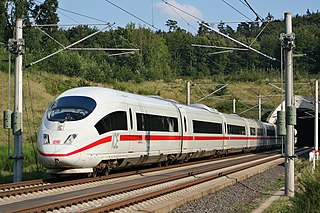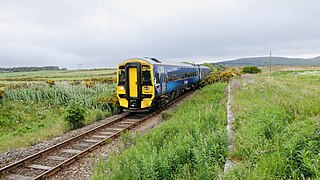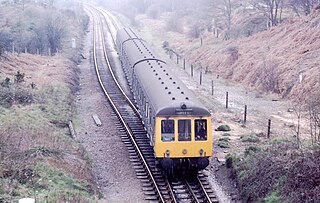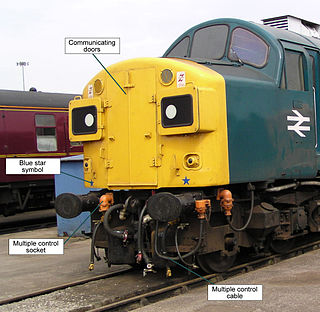Sprinter can refer to:
Sprinter can refer to:

A diesel multiple unit or DMU is a multiple-unit train powered by on-board diesel engines. A DMU requires no separate locomotive, as the engines are incorporated into one or more of the carriages. Diesel-powered single-unit railcars are also generally classed as DMUs. Diesel-powered units may be further classified by their transmission type: diesel–mechanical DMMU, diesel–hydraulic DHMU, or diesel–electric DEMU.

A multiple-unit train or simply multiple unit (MU) is a self-propelled train composed of one or more carriages joined, which when coupled to another multiple unit can be controlled by a single driver, with multiple-unit train control.

A railcar is a self-propelled railway vehicle designed to transport passengers. The term "railcar" is usually used in reference to a train consisting of a single coach, with a driver's cab at one or both ends. Some railway companies, such as the Great Western, termed such vehicles "railmotors".

The Siemens Desiro is a family of diesel or electric multiple unit passenger trains developed by Siemens Mobility, a division of the German Siemens AG conglomerate. The main variants are the Desiro Classic, Desiro ML, Desiro UK and the later Desiro City, Desiro HC and Desiro RUS. The trains are mostly used for commuter and regional services, and their rapid acceleration makes them suitable for services with short distances between stations. The design is flexible, and has become common in many European countries.

The British Rail Class 158Express Sprinter is a diesel multiple unit (DMU) passenger train. It is a member of the Sprinter series of regional trains, produced as a replacement for British Rail's first generation of DMUs; of the other members, the Class 159 is almost identical to the Class 158, having been converted from Class 158 to Class 159 in two batches to operate express services from London Waterloo to the West of England.

The British Rail Class 116 diesel multiple units were built by BR Derby from 1957 to 1961. Introduced as part of the British Railways Modernisation Plan in the mid 1950s, as with other first generation DMUs the 116 was intended to replace steam trains and reduce costs across the rail network. Alongside Metro-Cammell, BR Derby had prior experience with DMUs, having developed a Lightweight Unit, and so was awarded a contract for a new design.

The British Rail Class 150 Sprinter is a class of diesel multiple unit passenger trains; they were developed and constructed by British Rail Engineering Limited at York Carriage Works between 1984 and 1987 for use on regional services across the UK. The type is a second-generation design, built to more modern standards and based on BR's Mark 3 body design for longer-distance services. It was developed alongside the lower-cost Pacers, which were built using bus parts, for use on short-distance services. Two prototype units were built, followed by 135 production units in two batches. Subsequently, further members of the Sprinter family were also developed and introduced to service, including the Class 155, Class 156, Class 158 and Class 159.

An electro-diesel locomotive is a type of locomotive that can be powered either from an electricity supply or by using the onboard diesel engine. For the most part, these locomotives are built to serve regional, niche markets with a very specific purpose.

In rail transport, the expression power car may refer to either of two distinct types of rail vehicle:

The British Rail Class 155 is a diesel multiple unit passenger train. These DMUs were built by Leyland Bus at Workington between 1987 and 1988 as part of BR's replacement of its ageing first-generation diesel fleet. 42 units were originally built, of which only 7 remain; the other 35 units were converted to Class 153 railcars.

The British Rail Class 210 was a type of diesel-electric multiple unit (DEMU) passenger train designed and constructed by British Rail Engineering Limited's Derby Litchurch Lane Works.

On the UK rail network, multiple working is where two or more traction units are coupled together in such a way that they are all under the control of one driver.

The Sprinter is a family of diesel multiple unit trains in use on the British railway system. They were built in the 1980s and early-1990s by British Rail Engineering Limited (BREL), Metro-Cammell and Leyland. Sprinters operate in almost every part of Great Britain, from rural branch lines to commuter expresses into major cities.

The Networker is a family of passenger trains which operate on the UK railway system. They were built in the late 1980s and early 1990s by British Rail Engineering Limited and Metro Cammell. The trains were built for the Network SouthEast (NSE) sector of British Rail, which is where their name comes from. They are all multiple-unit trains.

Stadler FLIRT is a passenger multiple unit trainset made by Stadler Rail of Switzerland. The baseline design of FLIRT is an electric multiple unit articulated trainset that can come in units of two to twelve cars with two to six motorized axles. The maximum speed is 200 km/h (125 mph). Standard floor height is 57 cm, but 78 cm high floors are also available for platform heights of 76 cm.

A slam-door train or slammer is a set of diesel multiple units (DMUs) or electric multiple units (EMUs) that were designed before the introduction of automatic doors on railway carriages in the United Kingdom and other countries, which feature manually operated doors. The name came about because of the characteristic noise made by the passengers slamming the doors closed when the train was about to depart.

The CAF Civity is a platform of regional passenger trains which is manufactured by Spanish rolling stock manufacturer Construcciones y Auxiliar de Ferrocarriles. Available as both diesel, electric and battery-electric multiple unit, the Civity was first launched in 2010 and received its first order two years later.

An electro-diesel multiple unit (EDMU) or bi-mode multiple unit (BMU) is a form of a multiple unit train that can be powered either by electric power picked up from the overhead lines or third rail or by using an onboard diesel engine, driving an electric generator, which produces alternating current (AC) or direct current (DC) electric power.

The Intercity Nieuwe Generatie, or ICNG is an electric multiple unit trainset of the Dutch Railways. In addition to supplementing the existing intercity rolling stock, it will replace the Bombardier TRAXX locomotives and Intercityrijtuig coaches on the high-speed line between Amsterdam and Belgium. This will provide the connection that was originally planned to be provided by the Fyra service, which was cancelled in 2013.